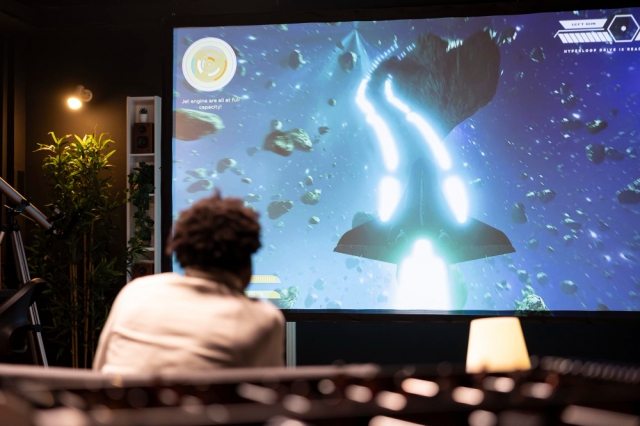Introduction
LED screens have become an integral part of our digital world, transforming everything from entertainment to advertising with their stunning visual clarity and energy efficiency. As technology advances, the role of LED screens continues to expand, offering innovative solutions across various industries. This article delves into the development, applications, and future prospects of LED screens, highlighting their significance in today's technology-driven environment.
The Development of LED Technology
Early Innovations in LED
The journey of LED technology began in the 1960s when the first practical LEDs were created for simple indicator lights. These early LEDs were limited in their applications, primarily due to their low brightness and limited color range. However, breakthroughs in the 1990s, particularly the development of high-brightness blue LEDs, unlocked the potential for full-color displays, paving the way for modern LED screens.
From CRT to LED:
A Technological Leap
Before LED screens became mainstream, Cathode Ray Tube (CRT) and Liquid Crystal Display (LCD) technologies dominated the display market. CRTs, with their bulky design and limited color accuracy, gradually gave way to LCDs, which offered slimmer profiles and better image quality. However, the arrival of LED screens marked a significant leap forward, combining the slim design of LCDs with superior brightness, contrast, and energy efficiency.
Continuous Improvements in LED Screens
The evolution of LED screens has been marked by continuous innovation. Some of the most notable advancements include:
Increased Brightness and Contrast:
Modern LED screens deliver exceptional brightness and contrast, making them suitable for both indoor and outdoor environments. This capability has expanded their use in outdoor advertising, public displays, and event staging.
Improved Durability:
LEDs are known for their durability and long lifespan, which reduces maintenance costs and ensures reliable performance over time. This durability is especially important for outdoor displays, which must withstand varying weather conditions.
Energy Efficiency:
One of the key advantages of LED screens is their energy efficiency. Compared to traditional display technologies, LED screens consume significantly less power, making them an eco-friendly choice for businesses and consumers alike.
Applications of LED Screens Across Industries
Entertainment and Broadcasting
The entertainment industry has embraced LED screens for their ability to deliver immersive experiences. In television studios, LED screens are used to create dynamic backdrops and virtual sets. In live events, such as concerts and sports games, large LED screens provide audiences with clear, high-definition visuals, ensuring everyone has a front-row experience.
Advertising and Public Displays
LED screens have revolutionized the advertising industry, enabling dynamic content that captures attention in busy environments. Digital billboards, for example, use LED technology to display vivid, animated advertisements that can be updated in real-time. In addition, LED screens are commonly used in public spaces to provide information, promote events, and enhance urban landscapes.
Retail and Consumer Experience
Retailers are increasingly using LED screens to create engaging shopping experiences. From digital signage that showcases promotions to interactive displays that allow customers to explore products, LED screens are transforming the way consumers interact with brands. Their ability to deliver high-quality visuals in various lighting conditions makes them ideal for indoor and outdoor retail environments.
Corporate Communication
In the corporate world, LED screens are essential tools for communication. They are used in boardrooms, conference halls, and training centers to display presentations, video content, and real-time data. The clarity and reliability of LED screens ensure that information is communicated effectively, whether to a small group or a large audience.
Educational Institutions
Educational institutions are adopting LED screens to enhance learning experiences. In classrooms, LED screens are used for interactive lessons, multimedia presentations, and video conferencing. Their bright displays and high resolution make them ideal for environments where visual clarity is crucial to effective learning.
The Environmental Impact of LED Screens
As businesses and consumers become more environmentally conscious, the energy efficiency of LED screens is a significant selling point. LED screens consume less power than older display technologies, reducing electricity usage and lowering carbon footprints. Moreover, the long lifespan of LED screens means fewer replacements are needed, which reduces electronic waste and further contributes to sustainability.
In addition to their energy efficiency, manufacturers are also focusing on using eco-friendly materials and sustainable production methods for LED screens. These efforts align with the growing demand for green technology and support global initiatives to reduce environmental impact.
The Integration of LED Screens in Smart Technologies
The rise of smart technologies has created new opportunities for LED screens to be integrated into various systems and devices. Some of the most exciting developments include:
Smart Displays in Urban Infrastructure
In smart cities, LED screens play a crucial role in urban infrastructure. They are used for traffic management, public safety announcements, and environmental monitoring. For example, smart LED screens in public transportation hubs can provide real-time updates on schedules and delays, improving the efficiency of urban mobility.
Interactive and Personalized Experiences
The integration of LED screens with artificial intelligence (AI) and the Internet of Things (IoT) allows for personalized and interactive experiences. In retail, for example, smart LED screens can display targeted advertisements based on customer preferences, enhancing engagement and driving sales. In homes, LED screens integrated with smart home systems can serve as central hubs for controlling various devices and accessing information.
Healthcare Applications
The healthcare industry is also exploring the use of LED screens in innovative ways. In medical facilities, LED screens are used for patient monitoring, surgical guidance, and telemedicine. Their high resolution and accuracy make them suitable for displaying critical medical information and images, supporting better patient outcomes.
Future Innovations in LED Screen Technology
The future of LED screen technology is bright, with several trends and innovations on the horizon:
MicroLED and Quantum Dot Technology
MicroLED technology, which uses smaller LEDs to achieve higher resolution and brightness, is expected to be the next big thing in display technology. This advancement offers even better color accuracy and energy efficiency, making it ideal for premium displays in televisions, smartphones, and wearables. Quantum dot technology, which enhances color performance, is also being integrated into LED screens to deliver richer and more vibrant visuals.
Flexible and Wearable Displays
Flexible LED screens, which can be bent and shaped without compromising image quality, are opening up new possibilities for wearable technology. These displays can be integrated into clothing, accessories, and even medical devices, providing users with interactive and personalized experiences on the go.
8K and Beyond
As the demand for higher resolution content grows, 8K LED screens are becoming more prevalent. These screens offer unparalleled detail and clarity, making them ideal for applications that require the highest visual quality, such as professional video production and medical imaging. With advancements in content production and distribution, 8K technology is expected to become more accessible to consumers in the coming years.
Sustainable Production and Recycling
The LED industry is increasingly focusing on sustainability, with efforts to reduce the environmental impact of production and improve recycling processes. Manufacturers are exploring the use of recycled materials in LED screens and developing systems for recovering valuable components from end-of-life products. These initiatives are crucial for minimizing the environmental footprint of LED technology as it continues to grow in popularity.
Conclusion
LED screens have become a cornerstone of modern visual communication, offering unmatched clarity, versatility, and energy efficiency. As technology continues to evolve, LED screens are poised to play an even more significant role in our lives, from enhancing entertainment and advertising to supporting smart cities and sustainable practices.
For those interested in exploring the latest developments in LED screen technology, the Led online sale offers a range of products that showcase the innovation and potential of this dynamic field. As we look to the future, LED screens will undoubtedly continue to illuminate the path forward, shaping how we see and interact with the world around us.






